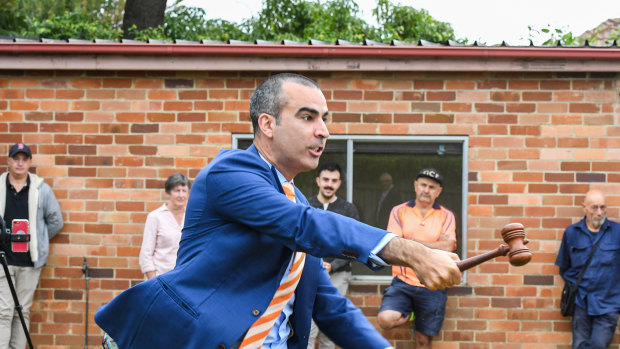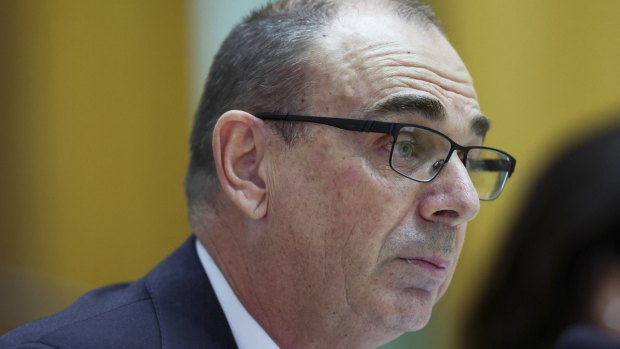This was published 4 years ago
Banking regulators poised to tighten lending standards to cool market
By Shane Wright and Clancy Yeates
The Reserve Bank and the nation’s prudential regulator are poised to tighten lending standards in the face of soaring property prices and growing household debt as Treasurer Josh Frydenberg says higher house prices are good for the economy.
The Commonwealth Bank, the nation’s biggest lender, revealed it would increase the interest rate it uses to assesses new loan applications, while the RBA and the Australian Prudential Regulation Authority are considering ways to temper some of the heat across the national market in coming weeks.

Hot auctions and surging house prices are poised to force the hand of banking regulators into tightening lending standards to cool the market.Credit: Peter Rae
Sydney’s median house value has climbed more than 15 per cent through the first 5 months of the year to $1.2 million while in Melbourne the median price is now at $908,000.
CoreLogic’s daily dwelling value index shows Sydney property values have increased by another 1.5 per cent through the first 17 days of June while in Melbourne they are up by 0.9 per cent.
Mr Frydenberg said on Friday that he has talked to both Reserve Bank governor Philip Lowe and APRA chair Wayne Byres about the housing market and the sharp run-up in prices.
He said higher house prices were a global issue as prospective buyers benefited from record low interest rates as well as government stimulus programs including the federal government’s HomeBuilder program.
In the case of Australia, owner-occupiers rather than investors were entering the market with a surge in first time buyers.
“It’s a good thing when the price of their home goes up, [it] gives them more confidence to consume, gives many small business who mortgage their home [the chance] to invest in their businesses. Overall it’s a good thing for the economy when house prices go up as opposed to going down,” Mr Frydenberg said.
But the Treasurer signalled there were limits to the benefits of such a lift in prices.
“We do need to monitor prices, we need to ensure it’s not over-heating and that is what APRA and the RBA are doing,” he said.
“I think it is important to monitor it closely and to ensure that we can continue to keep the focus on owner-occupiers because that’s what we’d like to see coming into the market.”

APRA chair Wayne Byres will oversee any changes to lending standards aimed at the property market.Credit: Dominic Lorrimer
This week, RBA governor Philip Lowe said while the bank did not target house prices it did maintain a close watch on household borrowing levels, which were already high because of the large amount of debt carried by many households. He said regulators have started discussing possible responses to a run-up in household debt.
Those responses include increasing required loan-to-value ratios on mortgages or directing banks to reduce their exposure to mortgages for investors.
This week the Reserve Bank of New Zealand, which has been directed by the Ardern government to take into account house price sustainability in its decision making, announced it was looking at a debt-to-income ratio limit on the size of mortgages.
This would allow first home buyers to continue buying into the property market but make it more difficult for those purchasing high-end properties and investors who are traditionally more highly leveraged.
The CBA is moving ahead of regulators, lifting its assessment rate from 5.1 per cent to 5.25 per cent, a move that is likely to pare back the maximum amount some customers can borrow.
Even though banks are promoting interest rates of less than 2 per cent, lenders must use higher rates when they are deciding whether a new borrower can afford a loan.
CBA said its decision took into account “the external environment and our regulatory commitments.”
“As part of our regular monitoring and review of our policies and services, we have made the decision to review our serviceability floor rate to ensure we continue to lend responsibly in the current low rate environment,” it said.
While the move will crimp some customers’ borrowing capacity, the bank said the “vast majority” of customers would be unaffected by the change.
Westpac chief economist Bill Evans on Friday said with the jobs market improving rapidly he believes the Reserve Bank will start lifting interest rates in early 2023.
Official interest rates, currently 0.1 per cent, could be at 0.75 per cent by late 2023.
Soaring house prices is also affecting federal government programs aimed at helping people enter the housing market.
Assistant Treasurer Michael Sukkar on Saturday announced an extra 30,000 places will be added to the government’s First Home Loan Deposit Scheme, its temporary New Home Guarantee program and the Family Guarantee system from July 1.
The government is also increasing the price caps under which the First Home Loan Deposit Scheme operates, in a sign that high prices are making it more difficult for people to get into the property market.
In Sydney and Melbourne the cap will be increased $100,000 to $800,000 and $700,000 respectively while for Brisbane it will increase by $125,000 to $600,000.
Recognising the lift in regional markets, the cap will be lifted by $150,000 in regional NSW to $600,000 while in regional Victoria it will be increased by $125,000 to $500,000.
The Morning Edition newsletter is our guide to the day’s most important and interesting stories, analysis and insights. Sign up here.